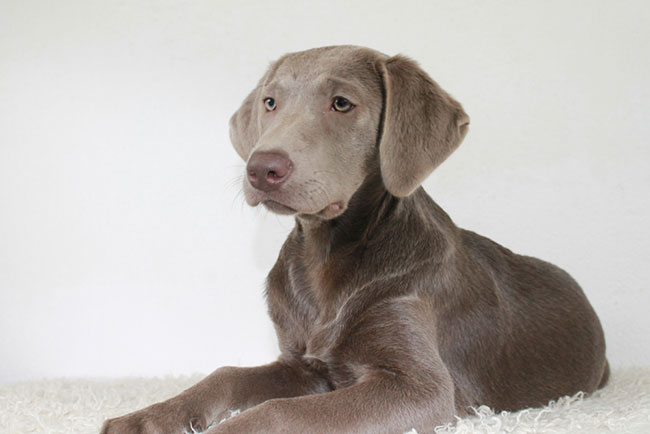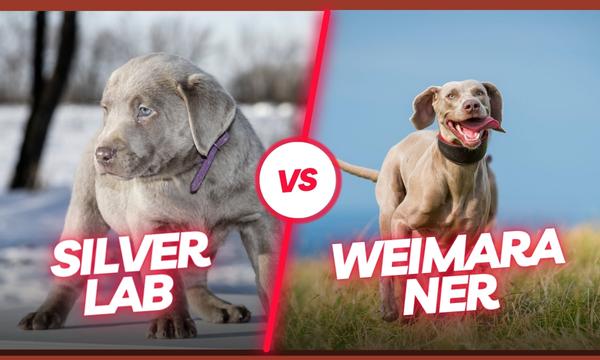
Silver Labs? Have you heard of them? These dogs are so beautiful that it looks like magic dust was sprinkled on them. While many of us are familiar with the black, yellow, or chocolate Labradors, Silver Labs grab your attention with their unique, shimmering coats that demand a second look.
Thinking, “Silver Labs? That’s a bit unusual!”? You’re spot on. They’re a special twist on the beloved Labrador, matching their intelligence, loyalty, and playful spirit but wrapped in a coat color unusual for dogs.
Dog lovers are pretty divided over them. Since the official Labrador clubs only recognize black, yellow, and chocolate, our silvery friends have sparked quite a bit of debate. Are they a rare gem, the latest trend, or just a quirky twist of genetics? That’s the big question everyone’s asking.
Let’s dive deeper into the world of these glossy companions. We’ll explore what sets them apart, the secret behind their striking silver coats, and why they’re capturing hearts everywhere despite not being the traditional color.
Table of Contents
- History
- Where Do Silver Labs Come From?
- Understand The Genetics Of Silver Labradors
- Why the Big Fuss?
- Are Silver Labs Purebred?
- Silver Labs Physical Characteristics & Temperament
- Silver Labs Health Concerns
- Silver Lab Vs Weimaraner
- Essential Nutrition and Grooming Tips for Your Silver Lab
- FAQ.
History
Labradors have been around for ages, right? They’re these friendly, loyal companions that originally helped fishermen in Newfoundland with their catch. Over time, they hitched a ride over to England, where they became the breed we’re all crazy about. Now, when you think about Labs, you usually picture the black, yellow, or chocolate ones. But then, there’s the Silver Lab, sort of the new kid on the block.
Where Do Silver Labs Come From?
Imagine it’s the 1950s, and in a litter of chocolate Labs, a puppy with a uniquely light coat is born. It’s like finding a pearl in an oyster—unexpected but beautiful. That’s the Silver Lab for you. How they exactly came to be is a bit of a head-scratcher. Some folks think they might have a bit of Weimaraner in their ancestry, which would explain the silver coat. But, let’s just say, not everyone agrees on this.
Understand The Genetics Of Silver Labradors
Let’s unravel the genetics behind the Silver Labrador Retrievers, kind of like we’re detectives piecing together a puzzle. Imagine genetics as the ultimate recipe book for every living thing, including our four-legged friends. In this book, there are recipes (genes) for everything from the color of their coats to the wag in their tails.
The Basic Color Genes in Labradors
Labradors come in three officially recognized colors: black, chocolate, and yellow. This variety is the result of two main genes:
- The B gene decides if a Lab’s coat is going to be dark (black) or light (chocolate).
- The E gene works on whether that dark or light coat will be expressed or if the dog will be yellow instead.
In the simplest terms, you’ve got a genetic light switch that flips between black, chocolate, and yellow, depending on the combination of these genes the dog inherits from its parents.
Where Silver Comes Into Play
Now, the Silver Labs enter the scene with a bit of genetic flair. Their stunning silver coat isn’t recognized by the big dog clubs as a standard color, and that’s because it’s the result of a dilution gene, known as the D gene. This gene takes the basic chocolate color and dilutes it, transforming it into the silver we find so mesmerizing. Read more here about the Polymorphisms within the canine MLPH gene are associated with dilute coat color in dogs.
Here’s a quick breakdown:
- A Lab needs two copies of the dilution gene (dd) to show a diluted coat color.
- When a chocolate Lab (which has the genetic code for a brown coat) inherits two of these dilution genes, one from each parent, their coat becomes silver.
The Controversy
What’s fascinating and a bit controversial is how this dilution gene made its way into the Labrador gene pool. Some folks speculate that way back, there might have been some crossbreeding with other breeds that carry the dilution gene, like Weimaraners, known for their unique gray coats. However, this idea remains a topic of debate among breed enthusiasts and experts.
Why It Matters
Understanding the genetics behind the Silver Lab helps us appreciate more than just their beauty. It opens up discussions about health, breeding practices, and the importance of genetic diversity in our beloved pets. While the Silver Lab’s coat color has sparked debate, it also highlights the complexity and wonder of canine genetics. Whether you’re a fan of their shimmering coats or just love Labs in general, there’s no denying that these dogs, with their friendly and loyal nature, make fantastic companions.
So, there you have it—the genetic mystery behind the Silver Labrador unraveled. It’s a testament to the diversity and unexpected twists in the world of dog breeding, showing us that nature always has a surprise up its sleeve.
Why the Big Fuss?
So, why do some folks get their feathers ruffled over Silver Labs? Well, the dog world is kind of like an old-fashioned club with strict dress codes. The American Kennel Club, a pretty big deal in that club, says Labs can only be black, yellow, or chocolate. Silver isn’t on their list, so Silver Labs are like rebels wearing jeans to a black-tie event. They’re registered as chocolate, but it’s a bit like sneaking into a party under a friend’s name.
Are Silver Labs Purebred?
It is the opinion of the Labrador Retriever Club, Inc., the AKC parent club for the breed, that a silver Labrador is not a purebred Labrador retriever.
https://thelabradorclub.com/the-issue-of-the-silver-labrador/
The Labrador Retriever Club, Inc. says that Silver Labs are not purebred Labrador Retrievers. People are worried because they think the dilute coat color (silver) doesn’t come from the pure Labrador gene pool and might result from breeding with other breeds, like the Weimaraner, which is known to carry the dilute gene (dd). This view is based on genetic evidence and that the only recognized coat colors for purebred Labradors are black, yellow, and chocolate. Silver is not recognized as a result of purebred breeding. On the website of The Labrador Retriever Club, you can read the full article for more information.
Silver Labs Physical Characteristics & Temperament

Silver Labrador Retrievers are like the silver screen stars of the Labrador world, with their eye-catching coats and endearing personalities. But beyond their unique color, Silver Labs share many of the same cherished physical characteristics as their black, yellow, and chocolate counterparts. Let’s walk through what makes these dogs stand out, not just in color but in build and presence.
Coat Color and Quality
The most distinctive feature of Silver Labs is, of course, their coat color. Their silver-grey coat comes from a dilution of the chocolate Lab’s coat color, thanks to the dilution gene (d allele). This results in a range of silver shades, from a light, almost mystical grey to a deeper, steely hue. Their coat is short, dense, and straight, with a water-resistant outer layer that makes them excellent swimmers and outdoor companions, just like the rest of the Labrador family.
Size and Build
Silver Labs are well-built and muscular dogs, showcasing a strong and athletic physique. They typically weigh between 55 to 80 pounds, with males usually being larger and heavier than females. Their body is well-proportioned, with a broad head, powerful neck, and a chest that’s deep and wide, giving them a sturdy, robust appearance. This build is a testament to their working dog heritage, reflecting strength and agility.
Head and Facial Features
Their heads are one of the many proud features, showing off a broad skull with a pronounced stop (the point where the nose meets the forehead), and medium-sized ears that hang close to their head, giving them a friendly, approachable look. Silver Labs have kind, expressive eyes that tend to be either hazel or amber, complementing their silver coat and adding to their striking appearance. Their eyes are one of their most expressive features, often described as showing an intelligent and gentle nature.
Tail and Paws
True to the Labrador breed, Silver Labs have what’s affectionately known as an “otter tail.” It’s thick at the base, gradually tapering towards the tip, and is covered in thick, dense fur. This tail is a powerful rudder, helping them swim with ease. Their paws are strong and compact, with webbed toes that are perfect for swimming, a characteristic feature of the breed.
Temperament
While temperament isn’t a physical characteristic, it’s worth noting that Silver Labs, like all Labrador Retrievers, are known for their friendly, outgoing, and loving nature. They are highly social, enjoy being part of the family, and are known to be excellent with children and other pets. Their physical attributes, combined with their gentle temperament, make them not only beautiful companions but also versatile working dogs, capable of excelling in roles such as hunting, service work, and therapy.
Silver Labs Health Concerns
Silver Labrador Retrievers share many traits and health concerns with other Labradors, but their unique silver-grey coat brings additional considerations. Here’s a look at some key health issues:
Color Dilution Alopecia (CDA)
CDA is a condition linked to the dilution gene that gives Silver Labs their coat color. It can cause patchy hair loss and itchy, flaky skin. While not life-threatening, CDA requires ongoing veterinary care to manage symptoms.
General Health Concerns
Silver Labs are also prone to common Labrador health issues:
- Hip and Elbow Dysplasia: Improper joint development can lead to arthritis and lameness.
- Ear Infections: Their floppy ears are susceptible to infections, requiring prompt treatment.
- Obesity: Labs love to eat, which can lead to obesity and related health problems like diabetes and joint issues.
- Heart Disease: Regular check-ups are important to catch and manage heart conditions.
- Hereditary Myopathy (HMLR): Affects muscles, leading to weakness. Awareness of this hereditary condition is crucial for potential owners.
Ensuring a Healthy Life
Proactive care is essential for Silver Lab owners:
- Regular Veterinary Check-ups: Annual visits help catch and manage health issues early.
- Proper Nutrition: A balanced diet helps prevent obesity and associated risks.
- Exercise: Regular exercise maintains a healthy weight and keeps joints healthy.
- Ear Care: Regular cleaning prevents infections.
- Genetic Testing: Provides insight into the risk of hereditary conditions.
By understanding their specific health needs, Silver Lab owners can ensure their pets lead healthy, happy lives.
Silver Lab Vs Weimaraner

The differences between a Silver Labrador Retriever and a Weimaraner extend beyond their similar coat colors. They stem from their distinct origins, physical traits, and personalities, making them suitable for different families and lifestyles.
Origins and Purpose
- Silver Labs: A variation of the Labrador Retriever from Newfoundland, originally used for retrieving fishing nets and as gun dogs. Their silver coat comes from a dilute gene in chocolate Labs.
- Weimaraners: From Germany, bred for hunting large game. Their heritage influences their physical traits and natural instincts.
Physical Traits
- Silver Labs: Stocky and robust with a friendly, expressive face typical of Labradors.
- Weimaraners: Sleeker and more aristocratic, with a statuesque build and amber or blue-gray eyes.
Temperament
- Silver Labs: Known for their good nature, friendliness, and trainability, making them great family pets.
- Weimaraners: High energy, intelligence, and loyalty but more demanding, needing significant exercise and mental stimulation to avoid anxiety.
Exercise and Training Needs
- Silver Labs: Energetic and adaptable to various living situations, generally easier to train due to their eagerness to please.
- Weimaraners: Require more intense exercise and engagement due to their hunting background and high energy levels.
Health Concerns
- Silver Labs: May face issues related to the dilute gene, such as Color Dilution Alopecia, in addition to common large breed issues like hip dysplasia.
- Weimaraners: Prone to conditions like bloat and certain genetic issues specific to their breed.
In summary, while their coat colors may be similar, Silver Labs and Weimaraners differ significantly in origins, physical traits, and temperaments. Choosing between them depends on your lifestyle and what you seek in a canine companion.
Essential Nutrition and Grooming Tips for Your Silver Lab

Caring for a Silver Lab involves attentive nutrition and grooming practices to ensure they stay healthy, happy, and looking their best. Here’s some advice tailored for your Silver Lab, from puppyhood through to their adult years.
Nutrition
1. Choose High-Quality Food: Select a high-quality dog food that’s appropriate for their age (puppy, adult, senior), size, and activity level. Look for foods with meat as the first ingredient to ensure they’re getting plenty of protein.
2. Puppy Nutrition: Silver Lab puppies grow rapidly and require a diet formulated for large breed puppies. This helps prevent them from growing too fast, which can put strain on their developing bones and joints.
3. Adult Nutrition: As your Silver Lab matures, transition to an adult formula that supports their energy levels. Labs are prone to obesity, so watch their calorie intake and adjust portions as necessary.
4. Senior Nutrition: Older Labs may need a senior formula with fewer calories but more fiber, and supplements like glucosamine and chondroitin for joint health.
5. Fresh Water: Always provide access to fresh, clean water. Hydration is key to overall health.
Grooming
1. Regular Brushing: Silver Labs have short, dense coats that shed. Brush them at least once a week to remove loose hair and distribute natural skin oils, keeping their coat shiny and healthy. During shedding season, you might need to brush more frequently.
2. Bathing: Bathe your Silver Lab as needed, but not so often that you strip their coat of natural oils. Every few months, or when they get particularly dirty, should suffice. Use a mild dog shampoo to protect their skin.
3. Ear Care: Their floppy ears can trap moisture and lead to infections. Check and clean their ears regularly with a gentle, dog-formulated ear cleaner.
4. Nail Trimming: Keep their nails trimmed to avoid discomfort while walking. If you can hear their nails clicking on the floor, they’re too long.
5. Dental Care: Regular dental care is essential. Brush their teeth several times a week with dog-specific toothpaste to prevent tartar buildup and gum disease.
Special Considerations for Silver Labs
- Skin Care: Due to the dilution gene, Silver Labs may have sensitive skin. Monitor for any signs of irritation or Color Dilution Alopecia, and consult your vet if you notice any issues.
- Diet and Exercise: Balance their diet with regular exercise to prevent obesity, a common issue in Labs that can lead to other health problems.
By adhering to these nutrition and grooming guidelines, you can help your Silver Lab maintain optimal health and a beautiful coat. Remember, regular vet check-ups are crucial to catch any health issues early and keep your furry friend in top condition.
FAQ.
Are Silver Labs Good Family Dogs?
Absolutely. Silver Labs inherit the Labrador Retriever’s renowned friendly, gentle, and loyal temperament, making them fantastic pets for families. They are patient and playful with children and get along well with other pets.
How Big Do Silver Labs Get?
Adult Silver Labs typically weigh between 55 to 80 pounds. Males generally reach heights of about 22.5 to 24.5 inches at the shoulder, while females are slightly smaller, standing around 21.5 to 23.5 inches tall. Their size reflects their strong, athletic build.
Are Silver Labs Rare?
Silver Labs are less common than the traditional black, yellow, and chocolate Labs, partly due to the specific genetic combination required for the silver coat color. However, their popularity has grown, making them more available than in the past.
Do Silver Labs Shed Bad?
Like all Labs, Silver Labs are moderate to heavy shedders, especially during the change of seasons. Regular grooming can help manage shedding, but expect some dog hair around the house.
Do Silver Labs Shed Less Than Other Labs?
No, the amount of shedding in Silver Labs is comparable to that of other Labrador Retrievers. The color of their coat doesn’t affect the shedding volume.
Are Silver Labs 100% Lab?
Yes, despite the unique coat color, Silver Labs are purebred Labrador Retrievers. The silver color is the result of a dilute gene affecting the traditional chocolate coat, not an indication of mixed breed ancestry.
Do Silver Labs Smell?
Any dog can develop a smell if not properly groomed, but Silver Labs are not particularly known for having a bad odor. Regular baths, ear cleaning, and dental care can help prevent any unpleasant smells.
Do Silver Labs Eyes Stay Blue?
While some Silver Labs may have blue eyes as puppies, this often changes as they grow. The adult eye color typically settles into lighter shades of brown or hazel, rather than maintaining the blue of their puppyhood.
Read More:
- Teddy Bear Dogs
- Labrador Retriever – Five Things You Should Know
- Can You Have a Black Goldendoodle?
- How to Pick a Purebred Puppy
Referece Links:




You just used 2000 words to say they might be a mix and ended with “now you know the truth”. 3 gens of registered parents don’t mean the 5 or 8th weren’t the mix. Also, this same breeder came up with the “pointing lab”. Coincidence?
Are you stalking websites? Nothing you said is relevant to the true purpose of the article. I don’t own a silver lab so no bias here. I was just curious about them. Are you one of those breeders who are stuck in closed register breeding? One day that kind of breeding will bite someone in the butt at the dog’s expense.